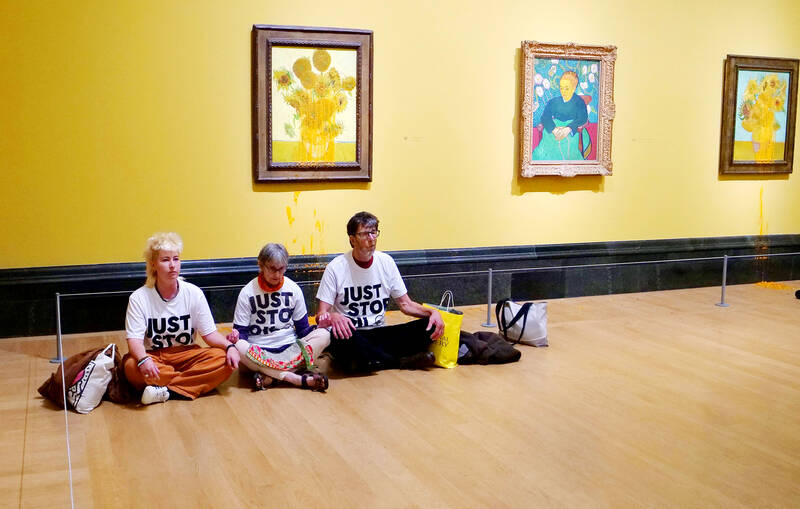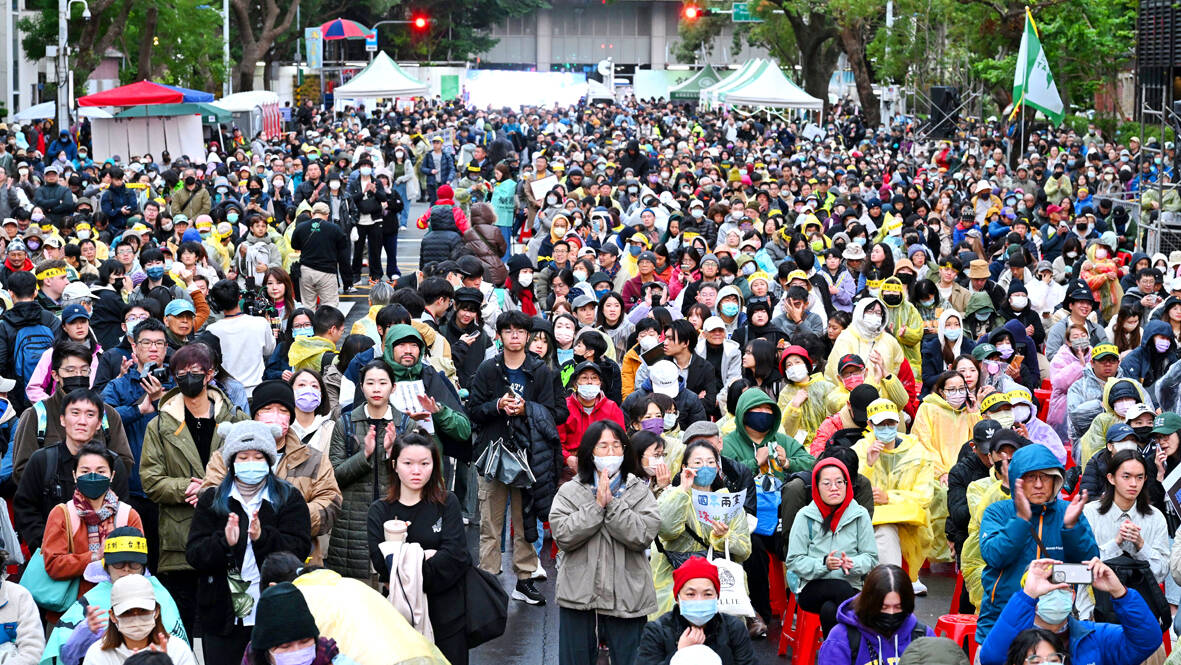On Sept. 27 last year, three climate activists were arrested for throwing soup over Sunflowers by Vincent van Gogh at London’s National Gallery. The Just Stop Oil protest landed on international front pages. But will the action help further the activists’ cause to end fossil fuels?
Scientists are beginning to find answers to this question. The number of protests more than tripled between 2006 and 2020 and researchers are working out which tactics are most likely to change public opinion, influence voting behavior, change policy or even overthrow political regimes.
“We are experiencing the largest wave of protests in documented history,” says political scientist Lisa Mueller at Macalester College in Saint Paul, Minnesota.

Photo: AFP
Successful protest movements tend to be large, non-violent, diverse, cohesive and occur at opportune times, studies show. But “it’s not like that there’s one silver bullet, one type of protest that is the most effective, hands down”, says Eric Shuman, who studies social change at New York University. Here are six factors linked to successful protests:
LARGE NUMBERS
One obvious thing effective protests have in common is they involve many people. That became clear when political scientists Erica Chenoweth and Maria Stephan studied 323 revolutionary campaigns worldwide from 1900 to 2006. These ranged from armed revolutions to strikes and boycotts.

Photo: Chen Yi-kuan, Liberty Times
All movements that assembled at least 3.5 percent of the population at their peak were effective in bringing about a change of political regime within a year. This led to what’s called the 3.5 percent rule: the idea that protests need to meet that threshold to trigger change. Chenoweth, a political scientist at Harvard Kennedy School, says that large numbers equal more political leverage. As a movement snowballs, it becomes impossible for those in power to ignore.
But successful revolutions probably have many more people than this backing them, even if they aren’t on the streets. A movement that mobilizes 3.5 percent “without gaining sympathy and support” from the broader public, Chenoweth says, might not have the necessary momentum.
PEACEFUL TACTICS

Photo: AFP
A body of research shows that non-violent protests appear more effective than violent ones.
“That’s one of the most robust findings,” says Mueller, who published a handbook for activists this year (The New Science of Social Change: A Modern Handbook for Activists). But when authorities violently repress protests, it backfires and appears to strengthen movements.
Omar Wasow, a political scientist at the University of California, Berkeley, saw this in a study of the 1960s US civil rights movement. He found that when protesters were violent, it prompted news stories focused on crime and disorder, and shunted votes to the Republican party, which was viewed as promoting law and order. A wave of violent protests after Martin Luther King’s assassination in April 1968 even tipped the election to Republican Richard Nixon, Wasow concluded.
By contrast, peaceful demonstrations that were violently repressed by police prompted media coverage sympathetic to the protesters. This shifted votes to the Democratic party, which was seen as supporting civil rights.
The impact of non-violent but disruptive tactics — such as throwing paint on Van Goghs or protesters gluing themselves to a wall — are less clear because fewer studies have been done. These garner publicity, but might undermine public support, an issue known as the “activist’s dilemma.”
“We don’t know where the balance is; it’s a fuzzy line,” says James Ozden, founder of Social Change Lab, a London group that studies social movements.
Some studies suggest disruptive action can work. Shuman and his team randomly assigned people to read mock news stories describing a protest against the police in which participants were either peaceful, violent or disruptive, by refusing to pay police tickets and fines. They found a combination of being non-violent and disruptive was the most effective at eliciting support. The disruption created a sense of pressure to do something, and “the non-violent nature of the protest was able to communicate that the protesters had constructive intentions,” Shuman says.
DIVERSITY
Movements that include a range of different people appear to be more effective than those that involve a homogeneous group.
“Diverse coalitions can suggest there is a broader electorate that could care about the protester’s issues,” says political scientist LaGina Gause at the University of California, San Diego.
A student protest might be more influential if it includes academics and the wider community as it shows it is more than a radical fringe.
Gause’s studies suggest protests are more likely to win support and concessions from lawmakers if they are costly to participants, through loss of wages or risk of repression, for instance. This shows that the cause is deeply felt. She points to events in 1965, when police brutally attacked civil rights activists marching in Selma, Alabama. The shock that followed helped pass voting reforms.
Gause argues that protests tend to be more costly for people of color, who are more likely to come into conflict with police, and for lower-income groups. But the message is “not to encourage organizers to engage in costly protests,” she adds. More, it’s a reminder that “slacktivism” might not be enough.
COHESION
Studies with clear demands are more effective than ones with diffuse goals, according to Mueller’s work. She illustrates this by comparing two London protest movements of similar size. The 2010 Take Back Parliament campaign in the UK involved coordinated slogans and demands for a fairer voting system. Mueller says this was important in driving a referendum on electoral reform in 2011, although voters rejected the change.
By contrast, participants in the Occupy London protests during the same year campaigned on a range of issues including global equality, economic reform, stopping wars and climate change.
“If you look at their placards, no two are alike,” Mueller says, and some politicians complained that the protesters’ goals were unclear. Even so, Chenoweth argues that the Occupy movement still had an impact by making inequality a household topic and convening activists who went on to other campaigns.
RIGHT PLACE, RIGHT TIME
An obvious but often overlooked factor in successful protests is that the circumstances need to be right. This might mean that the public is sympathetic to the cause and there are political allies “willing to champion a policy”, says Ozden.
Of course, these factors are mostly outside protesters’ control — as is chance, which plays a role in a movement’s impact. Polling from Social Change Lab showed that more people had heard of Just Stop Oil after a series of protests and media coverage in spring 2022 than before. But chance meant that protests later that year by Animal Rebellion — which campaigns against animal farming — failed to raise awareness: a change of prime minister and the death of Queen Elizabeth dominated the news.
PASSION
Research is far from the minds of many protesters, who take to the streets out of anger, grief or a desire for solidarity. That is an essential part of the recipe, experts say; without it, protests wouldn’t happen at all. But Mueller says activists are missing an opportunity if they don’t take advantage of science. “If they can maintain their emotional passion but keep part of the brain calculating the most effective way to channel that passion, that’s where the real power lies,” she says.
Yet protest studies come with caveats. It’s hard to prove a protest caused a later event such as change in opinion or regime, or if other factors did. It’s difficult to link a protest to a policy change when “politicians don’t want to say we were pressed by some radical group”, adds Ozden. And research literature is probably biased towards studies of large, high-impact protests over smaller ones.

On April 26, The Lancet published a letter from two doctors at Taichung-based China Medical University Hospital (CMUH) warning that “Taiwan’s Health Care System is on the Brink of Collapse.” The authors said that “Years of policy inaction and mismanagement of resources have led to the National Health Insurance system operating under unsustainable conditions.” The pushback was immediate. Errors in the paper were quickly identified and publicized, to discredit the authors (the hospital apologized). CNA reported that CMUH said the letter described Taiwan in 2021 as having 62 nurses per 10,000 people, when the correct number was 78 nurses per 10,000

As we live longer, our risk of cognitive impairment is increasing. How can we delay the onset of symptoms? Do we have to give up every indulgence or can small changes make a difference? We asked neurologists for tips on how to keep our brains healthy for life. TAKE CARE OF YOUR HEALTH “All of the sensible things that apply to bodily health apply to brain health,” says Suzanne O’Sullivan, a consultant in neurology at the National Hospital for Neurology and Neurosurgery in London, and the author of The Age of Diagnosis. “When you’re 20, you can get away with absolute

May 5 to May 11 What started out as friction between Taiwanese students at Taichung First High School and a Japanese head cook escalated dramatically over the first two weeks of May 1927. It began on April 30 when the cook’s wife knew that lotus starch used in that night’s dinner had rat feces in it, but failed to inform staff until the meal was already prepared. The students believed that her silence was intentional, and filed a complaint. The school’s Japanese administrators sided with the cook’s family, dismissing the students as troublemakers and clamping down on their freedoms — with

As Donald Trump’s executive order in March led to the shuttering of Voice of America (VOA) — the global broadcaster whose roots date back to the fight against Nazi propaganda — he quickly attracted support from figures not used to aligning themselves with any US administration. Trump had ordered the US Agency for Global Media, the federal agency that funds VOA and other groups promoting independent journalism overseas, to be “eliminated to the maximum extent consistent with applicable law.” The decision suddenly halted programming in 49 languages to more than 425 million people. In Moscow, Margarita Simonyan, the hardline editor-in-chief of the